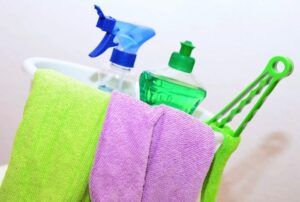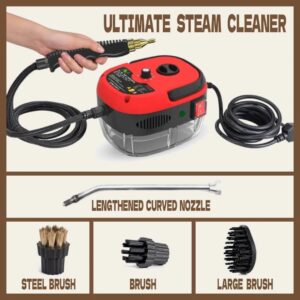Disinfecting tools for offices play a vital role in ensuring a safe and productive work environment. With the rise of workplace illnesses, maintaining cleanliness is more critical than ever as it directly influences employee well-being and productivity. A clean office not only reduces the spread of germs but also fosters a positive atmosphere that can enhance team morale.
In this article, we’ll explore various disinfecting tools available for office cleaning, discuss the advantages of manual versus automated options, and highlight best practices for effective disinfection. With the right tools and knowledge, you can create a healthier workspace for everyone.
Importance of Disinfecting Tools in Offices
In today’s fast-paced work environment, maintaining a clean and hygienic office space is more critical than ever. Disinfecting tools play a fundamental role in creating a safe workspace, helping to prevent the spread of germs and viruses that can lead to workplace illnesses. As organizations strive to enhance employee wellness, the consistent use of disinfecting tools is essential in fostering a healthy office atmosphere.The importance of cleanliness in the workplace extends beyond aesthetics; it directly correlates with employee productivity and overall well-being.
A clean workspace minimizes distractions and promotes focus, while also reducing stress levels associated with illness. Regular disinfection not only helps to keep surfaces germ-free but also enhances employees’ peace of mind, allowing them to perform at their best.
Impact of Cleanliness on Employee Productivity and Well-Being
A clean and well-maintained office environment significantly influences employee performance and satisfaction. Research has shown that employees working in sanitized spaces experience fewer sick days, leading to enhanced productivity. Here are some statistics that underline the importance of regular disinfection:
- A study from the American Journal of Infection Control found that thorough cleaning and disinfection of high-touch surfaces can reduce the transmission of viruses by up to 80%.
- According to the Centers for Disease Control and Prevention (CDC), approximately 1 in 3 employees reports being affected by workplace illnesses, emphasizing the need for proactive disinfection measures.
- Research by the University of Arizona revealed that office surfaces can harbor over 400 times more germs than a toilet seat, highlighting the importance of proper sanitation.
Regular disinfection not only reduces the risk of illness but also fosters a culture of care within the workplace. Employees are more likely to feel valued and appreciated by their employers when their health is prioritized.
“Cleanliness is not just about hygiene; it is about creating an environment that promotes health and productivity.”
Furthermore, the non-financial benefits of a clean office environment include improved morale, increased motivation, and a greater sense of community among employees. By investing in disinfecting tools and practices, organizations not only protect employees but also enhance their overall workplace culture.
Types of Disinfecting Tools for Offices
In today’s workplace environment, maintaining cleanliness is paramount. Disinfecting tools play a crucial role in ensuring that offices remain safe and hygienic, especially in the wake of health concerns. Various tools are available for disinfecting surfaces and equipment, each serving specific purposes and offering unique advantages.
Disinfecting Tools Overview
Office cleaning involves multiple types of disinfecting tools designed to tackle different cleaning challenges. The most common tools include:
- Disinfectant Sprays: These are versatile and can be used on a variety of surfaces. They often require a dwell time to effectively kill germs.
- Wipes: Convenient and ready to use, wipes are great for quick clean-ups and high-touch areas, but they may need to be replaced frequently.
- Foggers: Ideal for large spaces, foggers disperse disinfectant in a fine mist, reaching areas that are hard to clean manually.
- UV-C Light Sanitizers: Utilizing ultraviolet light, these tools can effectively kill pathogens on surfaces without the use of chemicals.
Comparison of Manual vs. Automated Disinfecting Tools
When it comes to disinfecting, you can choose between manual and automated tools. Manual tools require human effort for application but allow for precise control over the disinfecting process. On the other hand, automated tools often cover larger areas more quickly and efficiently.
| Tool Type | Manual | Automated |
|---|---|---|
| Application Method | Direct application by staff | Machine-operated, often requiring minimal supervision |
| Coverage Area | Limited, requires more time | Extensive, can disinfect large areas swiftly |
| Effectiveness | High, if used correctly | Very high, especially for hard-to-reach areas |
| Cost | Generally lower initial cost | Higher initial investment, potential long-term savings on labor |
Recommended Disinfecting Tools by Office Size and Type
Selecting the right disinfecting tools depends on the size and type of office. Below is a list of recommended tools tailored to various office environments:
- Small Office (1-10 employees): Disinfectant wipes and sprays are generally sufficient for easy maintenance and quick clean-ups.
- Medium Office (11-50 employees): A combination of disinfectant sprays, wipes, and a UV-C light sanitizer for thorough disinfection of shared spaces.
- Large Office (50+ employees): Foggers are recommended for broader coverage, supplemented by manual tools for high-touch surfaces.
- Healthcare Office: Comprehensive disinfectant systems that include foggers and UV-C light, along with regular manual cleaning practices.
“Investing in the right disinfecting tools not only enhances office safety but also boosts employee morale and productivity.”
Best Practices for Using Disinfecting Tools
In the wake of increasing awareness about hygiene in office environments, the correct usage of disinfecting tools is crucial for maintaining a safe workplace. Utilizing these tools properly not only ensures the health and safety of employees but also contributes to broader public health efforts. Here we Artikel effective practices for disinfecting tools in an office setting.
Step-by-Step Procedure for Disinfecting Tools
Implementing a structured approach to using disinfecting tools can enhance effectiveness and ensure that no area is overlooked. Below is a recommended procedure for disinfecting tools in an office:
- Gather Necessary Supplies: Ensure you have all required disinfecting tools, such as wipes, sprays, microfiber cloths, and personal protective equipment (PPE).
- Read Instructions: Always read the labels on disinfectants for usage guidelines, including dilution ratios and contact time.
- Prepare the Area: Clear the surfaces you intend to disinfect to facilitate access and ensure a thorough clean.
- Wear PPE: Equip yourself with gloves, masks, and goggles as necessary to protect from chemical exposure.
- Apply Disinfectant: Use the disinfectant according to the manufacturer’s recommendations, ensuring even coverage on the surface.
- Allow Contact Time: Let the disinfectant sit for the recommended time to effectively kill pathogens.
- Wipe Surface: After contact time, wipe the surface with a clean cloth to remove any residue.
- Dispose of Materials Safely: Properly dispose of used wipes and gloves to avoid cross-contamination.
- Wash Hands: After cleaning, wash your hands thoroughly with soap and water.
Safety Precautions While Using Disinfectants
Ensuring safety during the use of disinfectants is as important as the disinfection process itself. Proper precautions can prevent health hazards associated with chemical exposure. Here are key safety measures to consider:PPE should be worn as a standard practice. This includes gloves to protect skin, masks to prevent inhalation of fumes, and goggles to shield eyes from splashes.
“Always prioritize safety when using disinfecting agents; your health is paramount.”
Ventilation is also critical. Ensure that the area you are disinfecting is well-ventilated to minimize inhalation risks. Open windows or use fans to increase air circulation while applying disinfectants.
Frequency of Tool Usage in Different Areas
The frequency of disinfecting tools should be strategically determined based on the usage and exposure levels of different office spaces. High-touch areas require more frequent disinfection compared to general office spaces. High-touch areas, such as doorknobs, light switches, and shared equipment, should be disinfected multiple times a day, especially in busy environments. In contrast, general office spaces may only require disinfection once a day or a few times a week, depending on foot traffic and overall usage.
“Regular cleaning of high-touch areas can significantly reduce the risk of virus transmission in the workplace.”
Establishing a cleaning schedule can facilitate these practices. Utilizing a chart to track when and where disinfecting occurred can help ensure thorough coverage and accountability among staff.
Closing Notes

In conclusion, understanding the importance of disinfecting tools for offices is essential for maintaining a healthy workplace. By implementing effective disinfecting practices and utilizing the right tools, companies can significantly reduce the risk of illness among employees, leading to improved productivity and overall job satisfaction. Prioritizing cleanliness is not just about hygiene; it’s about creating an environment where everyone can thrive.
User Queries
Why is it important to disinfect office tools?
Disinfecting office tools helps prevent the spread of germs and illnesses, contributing to a healthier work environment.
How often should disinfecting tools be used in an office?
High-touch areas should be disinfected daily, while other spaces may be done weekly or as needed based on usage.
Are automated disinfecting tools more effective than manual ones?
Automated tools can cover larger areas more efficiently, while manual tools may allow for more targeted cleaning in specific spots.
What safety precautions should be taken when using disinfectants?
Always wear personal protective equipment (PPE) such as gloves and masks, and ensure proper ventilation in the area being cleaned.
Can I use household disinfectants in an office setting?
It’s best to use commercial-grade disinfectants that are specifically formulated for office use to ensure effectiveness and safety.




